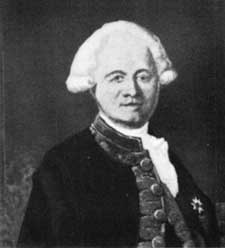|
FORT NECESSITY National Battlefield |
 |
 Capt. Lienard de Beaujeu. From Pennsylvania Magazine of History and Biography. |
 Capt. Jean-Daniel Dumas. Courtesy Public Archives of Canada. |
The Braddock Expedition (continued)
THE BATTLE ON THE MONONGAHELA. It was close to 1 o'clock when Braddock crossed the Monongahela and started beyond. Suddenly, the band of French appeared directly ahead. Beaujeu turned and waved his hat to those behind him. Instantly, the war cry was raised. Indians swarmed through the forest to the right and left of the British advance guard. Almost at the first exchange of shots, as Beaujeu fell mortally wounded, many of the Canadians fled from the field. The regular French officers under Captain Dumas, now in command, and Charles Langlade, leader of the Indians, rallied the warriors who poured a deadly fire from behind trees and rocks in two deep ravines. Especially destructive was the fire of the Indians from a small hill on the right of the British. Gage's men, in the vanguard, fell back upon the main body, resulting in increased confusion. Apparently dazed by the sudden and withering attack, the British fired aimlessly into the woods, often shooting down their own Colonial comrades who had chosen to fight Indian fashion from the cover of trees.
As the firing continued, Braddock rode forward. In the midst of the milling mass of troops around him, he apparently sought, as the only way out, to move on to the open country ahead. But every attempt to restore formation and move forward was cut short by the fire of the enemy. Five horses were shot from under General Braddock as he rode among his men trying to restore order. At last he fell, mortally wounded, shot through the arm into the lungs, just after he had ordered a retreat. In little more than 2 hours the battle was over, the army scattered, with most of its officers either dead or wounded.
The British had suffered a catastrophe. Of the 1,373 privates and noncommissioned officers, 914 were killed or wounded; of 86 officers, 63 were casualties. The French loss included only 3 officers killed and 4 wounded; among the privates, 4 French and 5 Canadians were casualties, While 27 Indians were killed or wounded.
All night long and throughout the next day the remnants of Braddock's army fled without order back over the road toward Dunbar's Camp. At Gist's Plantation they were met by wagons bearing provisions sent by Dunbar who had heard of the disaster from fugitives. The panic did not end with the arrival of the stragglers at Dunbar's Camp. Wild disorder prevailed in the camp as Dunbar's men, fearful that the French and Indians would suddenly fall upon them, began wanton destruction of arms and ammunition. In a frenzied attempt to make sure that his equipment and supplies did not fall into French hands, Dunbar destroyed four 12-pounder cannon; 324 rounds of canister were broken and shattered; more than 3,000 cannon balls and shells were buried; and 16,200 pounds of powder were dumped into a spring. Even 4 years after the incident, Col. James Burd, while passing Dunbar's Camp, "saw vast quantities of cannonball, musket bullets, broken shells, and an immense destruction of powder, wagons, etc. "
On July 13, the entire body began the retreat to Fort Cumberland. Toiling down the mountainside, they reached Old Orchard Camp. Here, late in the evening, the mortally wounded Braddock died. Early the following morning, as Washington read the Anglican service, the British general was buried in the middle of the road. Soon, the entire army passed over the grave, effacing all signs which might lead prowling Indians to the place. Three days later, the remnants of the ruined army reached the shelter of Fort Cumberland.
The French victory was rendered possible almost entirely by the powerful bands of Indians. The triumph in the Ohio country of the French and their Indian allies now seemed complete. Not the least of the consequences of this calamitous defeat was the sporadic outbreak of Indian warfare which ravaged the now unprotected English frontier settlements with harrowing and tragic violence. It was not until 1758 that a second and successful campaign finally relieved the Pennsylvania, Maryland, and Virginia frontier from Indian raids. In that year, Gen. John Forbes captured Fort Duquesne, the stronghold of the French in the Ohio Valley, and named the strengthened outpost Fort Pitt, in honor of William Pitt, the Prime Minister whose vigorous prosecution of the war had made victory possible.

|
|
Last Modified: Mon, Dec 2 2002 10:00:00 am PDT |


